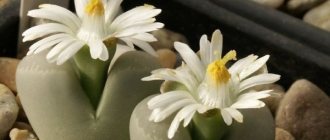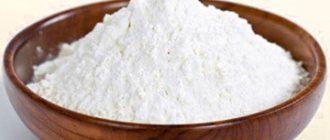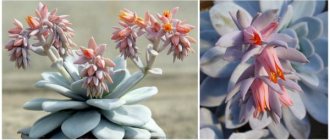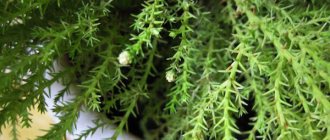The coffee tree is an exotic plant that decorates the apartment with an original, unusual appearance and fills it with a rich aroma. Caring for a coffee tree at home is not difficult, but requires knowledge of the peculiarities of its agricultural technology. For proper care, the evergreen plant will “repay” with lush, fragrant inflorescences and bright berries, from the grains of which you can prepare a natural, tonic drink.
What soil is needed for an Arabica coffee tree? Conditions and care
How to care for a coffee tree.
Like any southern tree, coffee prefers soft but bright diffused light (not direct sunlight!), room temperature 18-22°C and regular ventilation (not drafts!) with warm air. The soil for the coffee tree is heavy and acidic (pH no more than 5.5). You can prepare it yourself by taking leaf soil, greenhouse soil, and sand in a ratio of 1:1:1:2:1, or purchase ready-made PETER PEAT soil with an acidic reaction “Azalea. Hydrangea. Rhododendron" line HOBBY. The presence of chopped sphagnum moss in the soil (for example, “Sphagnum Moss” from the VITA line) will not hurt: it will maintain its acidity and perfectly retain moisture. The root system of the coffee tree is extensive and deep, so you will need a large and high planting container, as well as drainage from expanded clay from the VITA line or pebbles from the DECO line.
Watering
Water the tree only with settled, soft and slightly warmed water. From March to October, when the tree is actively growing and blooming, provide it with abundant watering, making sure that water does not accumulate in the pan and the roots do not rot. From November to February, the coffee tree is dormant and can be watered only after the surface layer of soil has dried.
Feed your pet with liquid humic fertilizer PETER PEAT “Living Force: for indoor plants” from April to September once every 2 weeks. When caring for it, do not “circle” or rearrange it, trying to achieve uniform illumination - the tree will shed its leaves and stop blooming. Transplantation and a new pot will be required annually (March-April), until the coffee tree reaches three years, and then every 2 years.
Trimming
The plant should be pruned as needed. Remove leaves and stems if they dry out. Form the crown by cutting off overgrown branches and giving them the required length.
Care instructions
Growing coffee will require the organization of certain conditions. However, the effort expended will be more than repaid due to the decorativeness of the bush. First of all, coffee is a solitary tree; it does not tolerate other plants around it. Therefore, you need to either allocate a separate window sill for it, or place a single cabinet for the plant not far from the window. At the same time, the flower does not like frequent movements, so the place should be permanent. And it’s better if there is a lot of free space around. In addition, the plant should not be rotated, especially during flowering, as the buds may fall off.
Delicious recipe! Why is folic acid prescribed?
Arabica coffee at home
Arabica coffee at home, as well as in natural conditions, is very demanding of light. It is best if it is bright but diffuse lighting without direct sunlight. South and east windows are ideal.
In the warm season, coffee trees also do well outdoors - on the balcony, in the summer cottage. However, you need to provide them with light shelter from the sun so that ultraviolet rays do not burn the crown.
In winter, the plant needs additional lighting with halogen or fluorescent lamps.
If the lighting in the apartment is weak, then the coffee tree may not bloom or bear fruit.
Temperature is also very important. Since coffee comes from the tropics, it does not tolerate cold weather. The minimum temperature in the room should not be below 20°C, especially in winter. The optimal temperature is +22…+24ºC. In winter, it is better to keep the plant away from heating sources to avoid drying out and falling leaves.
The coffee tree loves fresh air, so it is advisable to ventilate the room more often.
To successfully care for coffee, it is important to water the tree correctly. It is very demanding of moisture, especially during the period of growth, flowering and fruit formation:
- You can’t water a flower with tap water; it needs to sit for at least 1-2 days;
- the plant does not like lime, this also needs to be taken into account when watering;
- moisten the soil in the pot only with water at room temperature or 2-3ºC higher - both in winter and summer;
- If there is liquid left in the pan after watering, it must be removed.
The earth ball in the pot should always remain moist. The amount of water is increased in proportion to the increase in temperature in the room. Water regularly, but make sure that the water does not stagnate. The soil should never be allowed to dry out completely.
In winter, watering is reduced, but care is taken to ensure that the tree does not lack water.
Indoor coffee loves to be sprayed with warm water. Moreover, this can be done daily, especially in the warm season. It is better to spray in the morning or evening. In winter, the plant does not need this procedure, but if the foliage is dusty, you can wipe the leaves with a damp sponge.
Mineral supplements have a beneficial effect. They usually begin at the beginning of the growing season - in the spring - and are carried out until the flower bears fruit. It is recommended to fertilize 2 times a month with complex mineral fertilizer. You can feed with nitrogen and potassium salts at the rate of 3 g of potassium salt and 5 g of ammonium nitrate per 1 liter of water. The optimal rate for an adult plant is 1 liter per feeding time. You can combine mineral salts with organic matter (slurry), but the result must be observed. With the onset of autumn, feeding is stopped.
Soil for coffee trees at home. Preparing the soil for cultivation
Coffee loves acidic soils, which corresponds to the conditions of its homeland. The pH level for coffee should be between 4.5 and 5.5. At the same time, some gardeners recommend using soils for azaleas, hydrangeas or rhododendrons for coffee trees at home. However, you should pay attention to the acidity level.
If it is slightly higher than recommended (for example, soil pH for azaleas is 4.0), it can be used to grow a coffee tree, but if the soil is highly acidic (pH = 3.5), then it is better not to do this.
Fruiting coffee tree (Arabica), grown at home
Sometimes inexperienced gardeners purchase soil suitable for growing citrus fruits for a coffee tree. It is only partially suitable for the coffee tree, since its composition is acceptable, but it is more neutral than slightly acidic. You also need to know that approximately six months to a year after the start of active growing season, the soil under the coffee tree changes its composition and ceases to be acidic, shifting to neutral acidity.
In both of the considered cases, to ensure a normal acidity level for coffee, it is recommended to “acidify” the soil once a month. This is best done with lemon juice in a concentration of 3-4 drops per 1 liter of water. If you don’t have lemon on hand, you can use citric acid (2-3 grains per 1 liter of water).
The roots of the coffee tree are quite long, penetrating deeply into the soil. To ensure they have adequate supply of nutrients and air, it is necessary to use well-drained and loose compounds. The matted soil must be loosened and humus or peat added to it (depending on the acidity).
You can prepare the soil yourself. For this you will need:
- turf soil – 1 part
- leaf soil - 1 part
- humus - 1 part
- coarse river sand – 1 part
- peat – 2 parts
Sometimes it is recommended to add 0.5 parts of sphagnum moss to this composition for greater looseness.
How to plant correctly
This plant should be protected from sudden temperature changes and exposure to drafts. With proper care, the crop will bloom and bear fruit profusely.
Selection of capacity
The crop should be planted in a tall pot.
A high-quality drainage layer is of no small importance. The roots of the culture grow downwards
Soil requirements
The tree should be grown in a loose and acidic substrate. It is best to mix coarse sand, crushed coal, humus, and peat. These components are taken in equal parts.
Planting scheme
It is best to grow a crop from a grain. It should not be fried. To plant a plant, do the following:
- Soak the grain in a solution of hydrochloric acid or lightly saw it.
- Place the grain in a growth stimulator.
- Moisten and loosen the soil. Plant a seed. It should not be deepened too much.
- Place the pot in a lighted place. The temperature should be more than +20 degrees.
What soil is needed for a coffee tree? Where can I get a coffee tree seedling?
The first option is that a coffee tree can be grown from a grain (seed). Yes, in fact, coffee beans can be grown, but not from what is sold in stores. It is impossible to grow a coffee tree from the coffee beans we are used to, even if they are not roasted. To do this, you need to purchase special coffee tree seeds, these are sold in specialized garden stores. But when growing coffee from seeds, you will have to wait a very long time for the first flowering and fruiting.
The best option would be to purchase a rooted cutting from a coffee tree. Coffee cuttings are not expensive and fruiting can be achieved after only a year of cultivation. You can buy rooted coffee cuttings in nurseries (exotic plant stores) or from amateur collectors (such sales advertisements are usually posted on social networks and forums); when buying a plant on free classifieds sites (Ebay, Avito, OLX), they can very often deceive and sell the wrong thing, it is better to refrain from such purchases.
We bought a coffee tree seedling – what to do?
You bought a small coffee tree seedling, brought it home, and what to do next? The first step is to transplant the seedling from the shipping container into a permanent pot. Usually, during mass propagation and cultivation, inexpensive, square containers are used, which are filled with special soil to accelerate the growth of the plant’s root system. Such pots and soil are great for greenhouses, but are completely unsuitable for apartment window sills, they are not beautiful, and the soil in such pots dries out very quickly, which can lead to the death of the coffee tree. That's why a transplant is necessary.
Harvesting
By carefully caring for your tree, protecting it from pests and diseases, in 4-5.5 years you will be able to collect your first coffee harvest. Having noticed that flowers have appeared on the tree, it is recommended to have time to lather them. After all, their beauty is short-lived.
After 10 days, the flowers will be replaced by berries. They will ripen for about six months. Each of them contains only 2 coffee beans. The collection is done, just like the coffee beans are extracted, only by hand. Ripe berries, after being picked for about 30 days, are first dried in the sun, then they are dried in a dry black room for another month. Afterwards, you need to peel off the dried berry pulp and extract the coffee beans.
Growing a coffee tree at home is not difficult. But, like any plant, it requires attention and some care. With proper organization of its maintenance, you can become not only the owner of a lush, beautiful bush. Once collected, you will be able to prepare the most delicious coffee, grown on your home coffee plantation.
We hope that this article was useful to you, we would be grateful if you share it with your friends on social media. networks. Have a nice day and see you again!
Arabica coffee soil. Special soil for coffee tree
Coffee trees are very heat-loving plants. This is why ordinary soil is not at all suitable for a coffee tree. Growing a coffee tree at home is not at all difficult. The most important thing is to be patient.
The coffee tree begins to bear fruit in the third year, and the maximum yield is obtained after six to seven years.
Growing a tree from grain
An exotic plant like a coffee tree can be grown in two ways. The first of them is cuttings. If you have the opportunity to buy or get a cutting of such a wonderful plant somewhere, it is best to use this method. The fact is that the cutting will grow much faster than the shoot from the grain. And they develop fully, in breadth (in a bush), while the grain can stretch into a long bare (without leaves) stem.
The most suitable varieties for growing indoors are Arabian (arabika) and dwarf Nana (dad).
However, growing a coffee tree at home from a grain is much more interesting. There is nothing tricky or complicated in this process. Even regular unroasted coffee beans bought in a store are suitable for growing. Before putting a coffee bean into the ground, it is necessary to carry out pre-planting preparation. In order for the grain to germinate accurately, the hard outer shell must be slightly disturbed (sawed, broken or cut). Such delicate work may require some experience, but you can do without it. It is also necessary to soak the grains in a solution of stimulants, for example, Heteroauxin or Epin.
Return to contents
Ground and air
Planting coffee is not at all difficult, but the soil for such an outlandish plant must be special. The soil for growing coffee at home must be acidic, otherwise the grain will not be able to germinate. Of course, a beginner, and sometimes even a fairly experienced gardener, cannot accurately determine the acidity of the soil, which is why it is best to make your own composition:
The optimal temperature for growing a coffee tree at home is 22-25°.
- 20% river sand;
- 40% turf land;
- 30% leaf soil;
- 10% high peat.
Arabica trees grow just perfectly in such soil. However, in addition to the soil, special attention should be paid to air humidity.
It must be maintained, and standard spraying is not always enough. To solve this problem, you need to place the pot with the plant on a tray with small pebbles or expanded clay and pour water into it.
But even after this, the plant should be sprayed periodically.
Return to contents
Required lighting
Proper lighting for exotic plants is no less important than good soil. Of course, this plant does not make any special requirements. It loves light and warmth, but at the same time, excess sunlight can have a detrimental effect on the development of the sprout.
The most common mistake when growing a coffee tree is exposing the plant to direct sunlight.
The ideal place to place a pot with a coffee sprout would be the southeast or southwest. On the north side, coffee will also grow, but due to the lack of warm sunlight, its formation will be slower.
As mentioned above, excess sun can be harmful, but this applies mostly to young, not yet fully formed plants. In order for the coffee sprout to be healthy and develop well, it should not be exposed to direct sunlight.
As for adult plants, they simply need the sun to form inflorescences.
Return to contents
Transplanting and watering
In order for a coffee tree to grow and develop, it, like other house plants, must be replanted periodically. Young coffee cuttings are replanted every year. But adult fruit-bearing plants can be replanted no more than once every three to four years.
Water the plant with soft, settled water.
Before replanting begins, drainage must be placed at the bottom of the new pot. In addition, you should carefully examine the root system, removing diseased or rotten roots.
As for watering, it should be plentiful in the summer, but moderate in the winter. In order to correctly calculate the frequency of irrigation, it is necessary to take into account the temperature in the room where the coffee is grown. The soil for the coffee tree should always remain moist. In this case, you should avoid overmoistening and, of course, overdrying. It is better to water and spray a young coffee tree with soft water. Melt and rain liquid are most suitable for these purposes.
Some people believe that since coffee comes from the tropics, it needs the rays of the scorching sun all year round. This conclusion is fundamentally incorrect. Even on huge plantations in the tropics, other plants are planted around one coffee seedling for shading. Therefore, even in our conditions, it is impossible to leave a coffee sprout in open sunlight for a long time.
In cold weather, such exotic plants should be kept warm at a temperature of at least 18°C.
So that the plant does not need sunlight in winter, it must be illuminated with a fluorescent lamp.
Diseases and pests
The main problems that gardeners face when growing a coffee tree:
- the edges of the leaves darken and dry due to lack of air humidity;
- the leaves of the coffee tree turn yellow when rot appears at the roots;
- brown spots on the leaves appear when there is a lack of nitrogen in the soil;
- holes form in the leaf after sunburn;
- young leaves turn yellow, only green veins remain due to low acidity of the soil;
- leaves turn yellow, rot and fall off after excessive watering;
- In winter, leaves fall off when there is insufficient light;
- grows slowly if there is no regular feeding;
- leaves wrinkle and become covered with yellow spots when watered with hard water or lack of potassium;
- purple or brown spots appear on the leaves when there is a lack of phosphorus in the soil;
- young leaves are small and light yellow due to iron deficiency.
The most common pests found in coffee are scale insects, mealybugs and spider mites.
What soil for a coffee tree. Soil/soil for coffee tree
What kind of land is needed for coffee? (compound)
The coffee tree grows on soils with a slightly acidic pH of 5-5.5.
The following soil composition has proven itself well:
- Turf land - 40%;
- Leaf soil - 30%;
- Sand - 20%;
- Peat - 10%.
For seedlings up to 4 years old, the following soil composition may still be suitable: turf soil, sand, leaf soil in a ratio of 1:1:2. Such plants are replanted once a year.
For adult plants (5 - 10 years old), they also take turf soil, humus, leaf soil, sand in a ratio of 2: 1: 3: 0.5. This soil mixture is also suitable for older plants. They are replanted once every 3-5 years.
It is recommended to add sphagnum moss to the soil mixture. It will enrich the soil very well, provide it with acidity and maintain moisture.
In the photo below you will see what the components that make up the mixture look like:
Sod land
Leaf ground
Peat land
Method of preparing the mixture
The soil mixture should be prepared in advance. Experienced gardeners prepare the soil 2 weeks before transplanting so that it can settle. Disinfection by steaming or piercing in the oven is recommended.
If it is not possible to make a similar soil composition, then choose any Universal soil. A soil mixture for azaleas is even better; it also has an acidity pH of 4.5-5.5.
To it you need to add 25% sand and a little coal chips. To do this, you can use several tablets of activated carbon.
There is information that a young cutting of a coffee tree grows very well in a mixture of peat and perlite (this is a type of construction sand) in a 1:1 ratio. When planting, this mixture should be treated with a weak solution of potassium permanganate.
Attention! When planting, do not compact the soil! The soil should be light, loose, soft and not dry.
Enrichment of soil with mineral fertilizers
During the active growing season (spring - summer), feeding is carried out 2 times a month with diluted fertilizer from mullein or chicken manure.
Also, once a month the soil is fertilized with mineral fertilizers. The most suitable fertilizer for flowering plants or roses.
Therefore, 2 - 3 times a month, the water for irrigation needs to be acidified (2 - 3 drops of lemon juice per 1 liter of water).
It is very important to remember about drainage in order to prevent excess moisture in the soil.
It is important to know that with a neutral or alkaline soil reaction, the absorption of nutrients by the plant slows down. The development of the tree will be delayed, the leaves may turn black (necrosis will occur), and the tree will not bloom.
What kind of pot is needed for a coffee tree. Temperature and Lighting for Growing Coffee Trees
Coffee is a southern resident, but direct sunlight is contraindicated for it. Otherwise, the beautiful shiny leaves may suffer, their edges will dry out and the plant will lose its decorative effect. The following conditions are considered optimal: Abundant diffused lighting (eastern or western window). When placed on the south, southeast or southwest side, shading is required during the midday hours in summer and early spring. Fresh air and regular ventilation. No drafts - air flows during ventilation should not hit the coffee tree. Keep in the spring-summer period at a temperature of 22-26°C. Temperature drop in winter to 16-18°C.
Temperatures below 15°C will cause the plant to shed buds and leaves, and air colder than 12°C can be detrimental to the tree. During the heating season, the flower pot should not be located near heating devices. The coffee tree can be located on the north side, but in this case the growth process will be delayed, and it will not be possible to wait for flowering, especially beans, without sufficient sunlight.
How to feed coffee
For the plant to develop, flower and harvest, it must be fed every ten days . You can use diluted slurry as a fertilizer for homemade coffee. The ratio is 1 to 15. Other organic preparations that are sold in flower shops are also suitable.
Due to the decrease in temperature and amount of light in autumn and winter, the growth of the coffee tree slows down. Therefore, it is necessary to cut down on rations - one feeding every fifteen or twenty days is enough. Twice a month, coffee in the apartment must be sprayed with a solution of urea and potassium permanganate (1 g per liter).
Soil for coffee tree. Types of coffee trees
The Arabian coffee variety, popular for growing at home, is a compact tree. The leaves are shaped like an elongated ellipse with a dark olive tint, glossy on the outside and pale on the inside. The inflorescences are small, about 2 centimeters in diameter, collected in a bouquet. The size of the inflorescences directly depends on the growing conditions.
Once opened, flowers remain fresh for only a few hours. But the buds gradually open, not all at once. After the inflorescences fade, the fruit ripens in the form of a berry; when ripe it has a burgundy hue. Ripening occurs approximately 8 months after pollination. The paired fruits resemble round beans. This species reaches a height of up to 5 meters.
Coffee dwarf Nana is a neat plant, reaching a height of about 85 cm. It blooms profusely and subsequently bears fruit well at home. The tree can be given the desired design by trimming and pinching the tops of the plant.
Liberian coffee is also grown indoors. Its ripe fruits have a scarlet or sunny slightly orange tint. The length of its leaves reaches up to 40 cm, and the height is adjusted and the required shape is formed by trimming the crown of the plant. The inflorescence has a light shade and large fruits - berries.
Varieties
There are several varieties of coffee trees, each of which has certain characteristics.
Arabica
This tree is short and does not exceed 3-5 meters in height. It is distinguished by horizontal branches that are covered with green leaves. The plant blooms several times a year. This variety is considered the most popular.
Robusta
This is a powerful coffee that is often found in equatorial countries. The culture tolerates hot climates well and is resistant to diseases. She is considered very unpretentious to the conditions of detention. The bush is characterized by entire leaves that droop slightly. This type of coffee contains twice as much caffeine as Arabica coffee.
Dwarf Nana
The plant is compact in size and reaches 80 centimeters in height. The crop is characterized by abundant flowering and good fruiting even in indoor conditions. Proper pruning helps give the bush a beautiful shape and improve its decorative characteristics.
Liberian
This variety is characterized by red fruits. They may also have a rich yellow tint. The leaves reach a length of 40 centimeters. The plant has large seeds and white flowers. It grows quite large.











